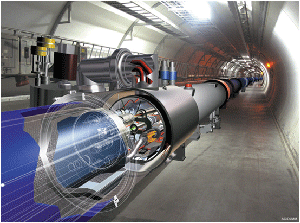CERN - ATLAS Experiment logo.
March 31, 2021
The ATLAS search achieves the world’s best constraints on the size of the Higgs boson’s self-coupling, creating a portal of better understanding into the fundamental Higgs mechanism
Image above: Candidate HH → ɣɣbb event in ATLAS data taken in 2017. Charged-particle tracks are shown in green, the two photons are shown as cyan towers and the two b-jets are shown as red cones. (Image: CERN).
Since the Higgs boson was discovered in 2012, scientists at the Large Hadron Collider (LHC) have been studying the properties of this very special particle and its relation to the fundamental mechanism essential to the generation of mass of elementary particles. One property that remains to be experimentally verified is whether the Higgs boson is able to couple to itself, known as self-coupling. Such an interaction would contribute to the production of a pair of Higgs bosons in the LHC's high-energy proton–proton collisions, an incredibly rare process in the Standard Model – more than 1000 times rarer than the production of a single Higgs boson! Measuring a Higgs boson self-coupling that is different from the predicted value would have important consequences; the universe might be able to transition into a lower energy state and the laws that govern the interactions of matter could take a very different shape.
At the ongoing Rencontres de Moriond conference, the ATLAS collaboration presented the result of a study that further explores this question. ATLAS physicists looked for the two intimately related Higgs-pair production processes that could be present in LHC collisions, though only one of these is related to the Higgs boson self-coupling and contributes favourably to the production of Higgs pairs when their total mass is low. These two processes interfere quantum mechanically and suppress Higgs boson pair production in the Standard Model. If a new physics phenomenon is at play, it could change the Higgs boson self-coupling and ATLAS might see more pairs of Higgs bosons than expected – or in particle physics parlance, measure a higher cross-section.
For their new study, ATLAS physicists have developed new analysis techniques to search for the rare process in which one of the two Higgs bosons decays to two photons and the other decays to two bottom quarks (HH → ɣɣbb). First, they divided the proton–proton collision events into low and high mass regions, so as to optimise the sensitivity to the Higgs boson self-coupling. Then, using a machine-learning algorithm, they separated the events that look like the HH → ɣɣbb process from those that don’t. Finally, they determined the cross-section for Higgs-pair production and observed how it varies as a function of the ratio of the Higgs boson self-coupling to its Standard Model value. This allowed ATLAS to constrain the Higgs boson self-coupling, between –1.5 and 6.7 times the Standard Model prediction, and also the Higgs-pair production cross-section. The result on the Higgs boson self-coupling is more than twice as powerful as the previous ATLAS result in the same Higgs-pair decay channel.
Large Hadron Collider (LHC)
Although this result sets the world’s best constraints on the size of the Higgs boson self-coupling, the work is just beginning. This is a preview of what is to come, as much more data would be needed to observe the Higgs boson self-coupling if it were close to its Standard Model prediction. Observing the Higgs boson self-coupling is indeed one of the raisons d’être of the High-Luminosity LHC (HL-LHC) programme, an upgrade to the LHC scheduled to begin operations in the late 2020s. The HL-LHC is expected to deliver a dataset more than 20 times larger than the one used in this analysis and to operate at higher collision energy. If Higgs-pair production is as predicted by the Standard Model, it should be observed in this huge dataset, and a more quantitative statement will be made on the strength of the Higgs boson coupling to itself.
Read more on the ATLAS website: https://atlas.cern/updates/briefing/twice-higgs-twice-challenge
Note:
CERN, the European Organization for Nuclear Research, is one of the world’s largest and most respected centres for scientific research. Its business is fundamental physics, finding out what the Universe is made of and how it works. At CERN, the world’s largest and most complex scientific instruments are used to study the basic constituents of matter — the fundamental particles. By studying what happens when these particles collide, physicists learn about the laws of Nature.
The instruments used at CERN are particle accelerators and detectors. Accelerators boost beams of particles to high energies before they are made to collide with each other or with stationary targets. Detectors observe and record the results of these collisions.
Founded in 1954, the CERN Laboratory sits astride the Franco–Swiss border near Geneva. It was one of Europe’s first joint ventures and now has 23 Member States.
Related links:
Higgs boson: https://home.cern/science/physics/higgs-boson
Standard Model: https://home.cern/science/physics/standard-model
Rencontres de Moriond: http://moriond.in2p3.fr/2021/
ATLAS collaboration result study: https://atlas.web.cern.ch/Atlas/GROUPS/PHYSICS/CONFNOTES/ATLAS-CONF-2021-016
Large Hadron Collider (LHC): https://home.cern/science/accelerators/large-hadron-collider
High-Luminosity LHC (HL-LHC): https://home.cern/science/accelerators/high-luminosity-lhc
For more information about European Organization for Nuclear Research (CERN), Visit: https://home.cern/
Image, Animation, Text, Credits: European Organization for Nuclear Research (CERN).
Best regards, Orbiter.ch



